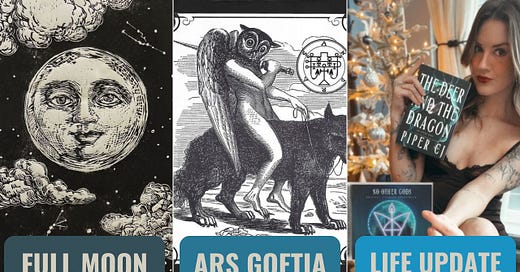January Newsletter: Demons, the Full Moon, and Life in a Nutshell
The "Infernal Pantheon", the Cold Moon, and catch up with a Folklorist
Hey friends and fae. Let’s launch this Substack into orbit just in time for the first full moon of the year.
If we have yet to meet: my name is Piper, and I have an M.A. in folklore. My parents said I’d never use that blasted two-year graduate degree, but the joke’s on them. I use it daily as a fantasy author, a perpetual yapper on social media, and as someone who’s never been attacked by a vampire.
Our inaugural post will kick off by telling you a little bit about what I’ve been up to. We’ll glance at the past year and make a plan for the upcoming year. We’ll follow it up with a chunky, albeit irreverent, folk lesson on the pantheon of demons (they’ve been on the brain as we lead up to the release of the second No Other Gods novel, which contains several titular demons amidst our “other gods”), and I’ll tie a bow on the post with the January full moon.
(Give it a quick scroll to get to the goodies if you’re here for folklore and full moons starting at Part II!)
PART I
It’s Me!
Did you make any resolutions for 2025?
I personally vow to be more unhinged. But before we dive headfirst into the chaos of the new year, here’s a recap of my 2024 timeline. It was another year of compulsively oversharing—one of those coping mechanisms I might work on in therapy… or just embrace as part of my yapper identity.
My 2024 Year in Review
January
I made Hazbin Hotel and Helluva Boss my entire personality. (The first is on Amazon Prime, the latter is free on YouTube. Both are fun demon cartoon media for anyone who enjoyed this folklore post!)
February
I celebrated my birthday in Mexico! It was the most sun I got all year. If I go again, I might even get in the water next time. (Unlikely. The ocean is monster soup.)
March
The Dawn and Its Light, the fourth and final book in The Night and Its Moon series, released! Completing the quartet was a huge milestone—woohoo!
April
The moss and ferns were phenomenal this spring in the PNW. My entire photo album from April is just moss pictures. Zero regrets.
May
The Deer and the Dragon, book one in the modern mythology series No Other Gods, released and hit #22 on the USA Today bestseller list! To this day, it’s my favorite thing I’ve ever written. (Well…my favorite published thing. More in store!)
June
Surprise! I love Las Vegas trips. I know, it seems “un-Piper-like” given my introversion, but Vegas has incredible spas, restaurants, sunshine, pools, and window shopping. You don’t even need to “people.”
July
I took out my extensions and cut my hair above my shoulders for the first time in years. I loved it for a few weeks…and have spent the rest of the year regretting it immensely. Learn from my mistakes.
August
I attended Seattle’s infamous Seafair on the boats and had one of the worst sensory meltdowns of my life. As you may or may not know, I’m on the spectrum, and my particular brand of neurodivergence was pushed to the limit. I ended up hiding under a chair in a corner of a boat with my hands over my ears for hours until the kindness of strangers helped me off. #NeverAgain
September
I donned my favorite medieval garb and attended the Shakopee RenFaire. Yes, I went full cosplay mode. Yes, it was magical.
October – Part I
The Graveyard Gift, book one in the cozy, spooky middle-grade series Fern’s School for Wayward Fae (perfect for fans of Wednesday, Narnia, and A Series of Unfortunate Events), released! It squeaked into the last slot on the New York Times list, and I celebrated with tears and a bottle of Piper champagne that had been hiding in my fridge forever.
October – Part II
I surprise-dropped a spicy, sapphic vampire novella called This Book Sucks. It’s available on KU and paperback internationally via Amazon and marked the start of what I hope will be a fun, regular occurrence of indie novellas.
November
What a month for hard lessons in the industry. I learned that while some are fortunate to have supportive teams, others encounter what feels like threats or deceit. Fortunately, I had amazing publishers who helped me navigate murky waters, identify the source of the problem, and move forward. I believe in talking about the tough stuff—misfortunes have power over us in silence, and the powerful benefit from that silence.
December
I wrapped up writing and editing deadlines and dove back into one of my favorite hobbies: gaming! Whether it’s killing zombies, building houses, running from haunted trains, or solving puzzles, I occasionally stream on Twitch. Feel free to join me!
What’s Up for 2025?
Modern Mythology with a Little Spice
Do you like free things?!? Like amazing art??? Like bonus content?? Like an ORIGINAL SOUNDTRACK BY TALENTED MUSICAL ARTISTS??! Heck yes, I saved some of the coolest information for last: the Bookish Song Collective is releasing a goddamn incredible original No Other Gods soundtrack. I’ll be posting snippets, song reactions, and as much as I can about this over the next few weeks before it drops!
Please, for the love of the other gods, preorder The Fox and the Falcon from Mysterious galaxy so you get a signed copy with sprayed edges and vellum art overlays of Fauna and Azrames!
The Mysterious Galaxy preorder ends on February 1st, so if you like free bonus things, order it from them before it’s over!
Gothic, Cozy Middle Grade Fantasy
I’ve got a series for the young and young at heart. If you want to share the Seelie and Unseelie court, cryptids, fae, and fantasy with your nieces, nephews, niblings, your classroom, your kiddos, and your inner child.
I used this series to heal the part of me that was heartbroken by harmful, transphobic rhetoric by she-who-must-not-be-named as we erase H*rry P*tter from our lives.
The first book, The Graveyard Gift, follows part-fae student Rosemary Thorpe, a girl with the unfortunate ability to see how people die. The second book, The Grim Adventure, drops May 6th everywhere! Get this gorgeous little hardcover treasures with interior art, foiling, and monsters from across folklore to learn what it means to be good and bad.
Oracle Fundraisers, Indie Novellas, Travels, and Socials
- Join me this spring as I continue to run oracle reading fundraisers to pay for the costs affiliated with the indie novellas (support human art by hiring real artists for our cover art, our character art, and everything in between, as we rage against the AI tidal wave). Editing, formatting, and the frequent need to hide in a pub and the costs affiliated with ordering drinks so they don’t kick me out. (I cannot be trusted to remain focused alone in my home when errands, chores, video games, and Netflix are right there.)
- I’m planning at least one indie novella for the spring (hint: spicy queer ghost folklore), and hope to continue releasing them!
- As many of you may or may not know, I lived in Southeast Asia (mostly in Vietnam and then a winter in Singapore) for many years, and have been aching to go back ever since covid closed the boarders and changed the geographical course of my life. I’d like to take a work trip to sequester myself among the $2 hearty meals of bánh xèo, sunshine, and ride my little scooter to and from the grocery store while I get ahead of all of my deadlines for the new year. Fingers crossed I can make this happen!
- I post daily on Instagram, engage with readers as they read and react in the Discord, answer questions, give pep talks, and make videos on Cameo, and now, thanks to your support, have a substack underway! Will I continue making videos? I don’t know. They rarely spark joy. But I still love writing, folklore, and yapping, so we’ll see what forms it takes.
Enough about me. Let’s learn about demons, and get ready for the January full moon. Shall we?
PART II: FOLKLORE
The Infernal Divine: Exploring the Demon Pantheon of the Ars Goetia
We know the Greek Pantheon, the Norse Pantheon, and the famous gods and goddesses across the globe. But did you know there was a pantheon of demons, known as the Infernal Divine? While pop culture has largely turned demons into snarling, horned beasts or horror movie antagonists, the spirits in the Ars Goetia—the first book of the Lemegeton, or The Lesser Key of Solomon—are something entirely different. They’re described as articulate, intelligent, and occasionally even beautiful, blending ancient deities, djinn, and spirits into a hierarchy of supernatural power.
Before we go any further, let me put on my folklorist hat. Folklore is an academic discipline dedicated to documenting and analyzing the beliefs, practices, and stories of the folk. What follows is not spiritual or religious advice—it’s an exploration of the traditions, legends, and cultural histories surrounding these spirits. No summoning circles required.
The Ars Goetia and Solomonic Demons: A Different Kind of Spirit
Let’s start by differentiating between Hollywood demons and Solomonic demons.
Hollywood Demons: These are your standard horror fare—feral, frothing monsters intent on infestations, chaos, and torment. This portrayal, while entertaining (if not a bit overdone), owes more to Christian adaptations of possession narratives than to the traditions found in the Ars Goetia.
Solomonic Demons: In contrast, the spirits of the Ars Goetia are closer to minor deities or djinn. They are powerful, highly intelligent, and often articulate. Some are even described as beautiful. Rather than frothing at the mouth, they’re known for imparting wisdom, revealing secrets, or offering aid in highly specific areas—if summoned correctly. The process of “demonizing” them came later, as Christianity sought to reshape these spirits into embodiments of fear and sin, often stripping them of their nuanced origins.
I opted to do the Infernal Divine for my first substack largely because I’m fascinated with the differentiation between Hollywood demons and Goetic demons, and wanted to bring the Goetic flare into my own modern mythology series. (Hold on for a plug) This nuanced approach to demons is something I explore in my No Other Gods series, a modern mythology about pagan gods, demons, angels, and fae. One of the central characters is Caliban, the Prince of Hell, who—like the spirits in the Ars Goetia—is far more than the one-dimensional villain pop culture might expect. He’s cunning, charismatic, and deeply tied to the story’s themes of power and redemption.
Book One is currently available on Kindle Unlimited, and I’m thrilled to announce that Book Two comes out next month. If you love the idea of complex demons with their own agendas, you won’t want to miss it.
Oh, and, before I return to the folk tale: If you preorder book two from Mysterious Galaxy before February 1st, you’ll get to follow the Prince of Hell and his human through pantheons with the following perks: signed copy, sprayed edges, vellum art overlays of Fauna (from the Nordic pantheon) and Azrames (of Hell).
Now, back to our scheduled demons.
Asmodeus: A Legendary Rebel with a Broken Heart
Like any deity, the goetic spirits often come with lives, legends, and lore. Unlike other deities, few of us know their tales.
One of the most infamous spirits in the Ars Goetia is Asmodeus, a figure steeped in legend and drama. Asmodeus, a King of the Infernal Divine, is remembered for his immense wrath, his cunning, and a tragic love story that rivals anything in popular mythology.
The Legend of Solomon vs. Asmodeus
The story goes that King Solomon, with his magical ring and divine authority, summoned and attempted to bind Asmodeus to his will. This did not go as planned. Asmodeus, enraged by Solomon’s audacity, not only refused to submit but threw Solomon across the world. If that wasn’t humiliating enough, Asmodeus borrowed Solomon’s face, infiltrated his court, and reportedly seduced both Solomon’s wife and his mother. This tale underscores just how dangerous and uncontrollable these spirits could be—even for someone as “powerful” (or with disrespectful levels of audacity) as Solomon.
Asmodeus and Sarah
The tragedy of Asmodeus doesn’t end there. According to Jewish folklore, he was deeply in love with a human woman named Sarah. His love for her was so consuming that he killed any human suitor who dared to court her. This aspect of his legend paints Asmodeus as more than a villain; he’s a figure of heartbreak, jealousy, and obsession. The story of Sarah and Asmodeus reflects broader themes in folklore about the dangers of love and the blurred lines between devotion and destruction.
The Ars Goetia: A Pantheon of Power and Nuance
The Ars Goetia contains descriptions of 72 spirits, each with distinct abilities, ranks, and appearances. These spirits weren’t seen as mindless forces of evil but as entities with specific knowledge and powers. Here are a few notable examples:
Duke/Duchess Astaroth, 29th spirit of the Ars Goetia: A figure riding a dragon, holding a viper. Reveals secrets of the past, present, and future. (Mythology note: “Astaroth” is believed to be connected to the Phoenician deity Astarte, the goddess of fertility, love, and war).
King Paimon, 9th spirit of the Ars Goetia: A crowned figure on a camel, accompanied by musicians. Teaches philosophy, sciences, and occult arts. (Hollywood note: this is the deity of the Infernal Divine we see portrayed in “Hereditary” starring Toni Collette as a member of his cult)
Prince Seere, 70th spirit of the Ars Goetia: A beautiful man or angelic figure riding a winged horse. He’s a spirit of generosity and riches, known for granting treasures to the summoner. He’s considered a “kind” spirit who neither manipulatives nor deceives the summoner.
President Marbas, 5th spirit of the Ars Goetia: Takes the form of a lion or a man. Reveals hidden truths, heals diseases, and can shape-shift humans. (Folk note: C.S. Lewis was quoted saying he had an “unhealthy taste for the occult”, and I remain convinced that Aslan, though allegory for the Bible’s Jesus, was heavily influenced by President Marbas)
These spirits were often summoned for practical purposes: knowledge, wealth, healing, or influence. They reflect a worldview in which the supernatural wasn’t something to fear but something to engage with carefully, respectfully, and with an understanding of the risks. Unless you’re Solomon, who was pretty confident that he could treat any spirit like a djinn, bent to his will. As we know from the tale of Asmodeus, Solomon’s hubris came with steep consequences.
The Infernal Divine and the Folklore of Fear
What makes the Ars Goetia so fascinating is not just the spirits themselves but the cultural context that shaped their stories. Many of these spirits began as gods or neutral entities, later demonized as religious power structures shifted. Asmodeus, for example, likely traces his origins to Aeshma, a Zoroastrian demon of wrath. Astaroth was believed to once be Astarte, a goddess of love and war in ancient Canaanite and Mesopotamian religions. These transformations tell us more about human fears and biases than about the spirits themselves. The Christian tradition has demonized—literally—very real deities from neighboring pantheons they deemed inferior, then created massive terror around the deities to destroy their legends and goodwill within the culture.
A Folklorist’s Takeaway
As a folklorist, I find the Ars Goetia a compelling snapshot of humanity’s evolving relationship with the divine, the unknown, and the “other.” It’s a reflection of how we’ve reinterpreted ancient gods and spirits to suit our fears, our needs, and our narratives. It’s a brilliant example of how the lens of folk belief (for example, reexamining “enemy” deities through the lens of Christian culture) could change the perception of 72 deities forever.
So, the next time you watch a horror movie demon flailing and frothing, remember that the Infernal Divine are more likely to school you on philosophy, steal your girlfriend, or relocate you across the globe for kicks—because who says demons don’t multitask?
PART III: MOON
The Wolf Moon
1st Full Moon of 2025
January 13th, 2:26 Pacific / 5:26pm east
Nestled in the astrological waters of Cancer, it brings with it a tide of emotions (and probably some overly ambitious New Year’s resolutions). While I defer to Red Robe Astrology for the celestial details, we’ll stick to what’s in my wheelhouse: folklore, traditions, and wolves—because obviously.
Where does it get its name?
While animal behavioral scientists will insist that there is no link between lunar phases and wolf activity, folk knowledge holds a firm belief that wolves, do indeed, howl at the moon. As they’re nocturnal creatures (technically, they’re “crepuscular”, meaning they prefer low lighting, but who the heck knows that word?), their activity is more likely to happen under the light of the moon. January’s moon gets its name from a perceived increase of wolf activity as our fellas go hunting through the snow, but it’s not the only name for the January moon.
Indigenous names paint a vivid picture of just how brutal this time of year can be. The Assiniboine called it the Center Moon to mark the midpoint of winter’s wrath. The Cree went with Cold Moon or the far-more-dramatic Frost Exploding Moon (yes, please). Meanwhile, the Dakota named it Severe Moon, and the Algonquin opted for the self-explanatory Freeze Up Moon. Honestly, if that doesn’t make you want to bundle up and light a fire, nothing will.
Full Moon Folk Practices
Humans, always looking for a reason to make a little magic, have long treated full moons as opportunities to connect with something greater than themselves. January’s Wolf Moon is no exception.
Charging Crystals: Whether it’s quartz or amethyst, setting your stones out under the moonlight is said to cleanse them of past energies. (Bonus: It makes for an aesthetic Instagram story. Win-win.)
Moon Water: Leave a jar of water under the full moon to soak up its energy. What do you do with it? Some people drink it, some bathe in it, and others sprinkle it around their homes like a protective salt circle but wetter.
Simmer Pots: Throw some cinnamon sticks, orange slices, and cloves into a pot of water, and let it simmer. Your house will smell amazing, and you can pretend you’re casting a low-stakes spell to ward off seasonal depression. I like to use Cunningham’s Encyclopedia of Magical Herbs to seek out fruits, vegetables, plants and the like that align with my intention (e.g. luck, protection, banishing ghosts)
Release Rituals: Write down the things you’re ready to let go of—a bad habit, a toxic ex, the memory of that time you called your boss “Mom” by accident. Burn the list under the moonlight and watch your emotional baggage go up in smoke.
Moon Myths and Predictions
If you’re the type to consult the Farmer’s Almanac (or, you know, a weather app), you’ll find some charming superstitions tied to January’s full moon. According to this ancient guide to everything from planting corn to predicting rain, a bright first full moon promises a rainy season and a bountiful harvest. Conversely, a red-tinted moon means you’re in for a dry year. (Here’s hoping for rain; I’d rather deal with mud than wildfires any day.)
And don’t stray too far from your cauldron (or coffee pot).
Next month, we’ll dive into weather divination as foretold by a magical rodent (looking at you, Punxsutawney Phil) and explore how this ties to the goddess Brigid and the ancient festival of Imbolc. Spoiler to the Pennsylvania Deutch perpetuating the practice: using a groundhog for weather divination is witchcraft.
That’s a wrap on letter one! I post regular updates on my Instagram story, connect with friends over quotes and spoilers in the discord, do fun videos, peptalks, and answer questions on cameo, and now, I write newsletters that I hope someone enjoys. Or, at least if you hate it, I hope you’re enraged in a way that feels educational and moderately entertaining.
Make your moon water, tip your waitresses, be kind to each other, and if you’re looking for something to read in the new year, why not consider supporting your internet folklorist.
Thank you for your support, and with that, an unceremonious exit: love you, bye.












This was a fun and intriguing first newsletter!!! Was perfect to read with my lunchtime coffee, and remind me to prepare for the full moon tonight and go preorder your books from my local indie bookshop.
What an excellent launch! This may be my favorite folklore format/Piper project. Thank you for making this adventure of information available to us 🙌